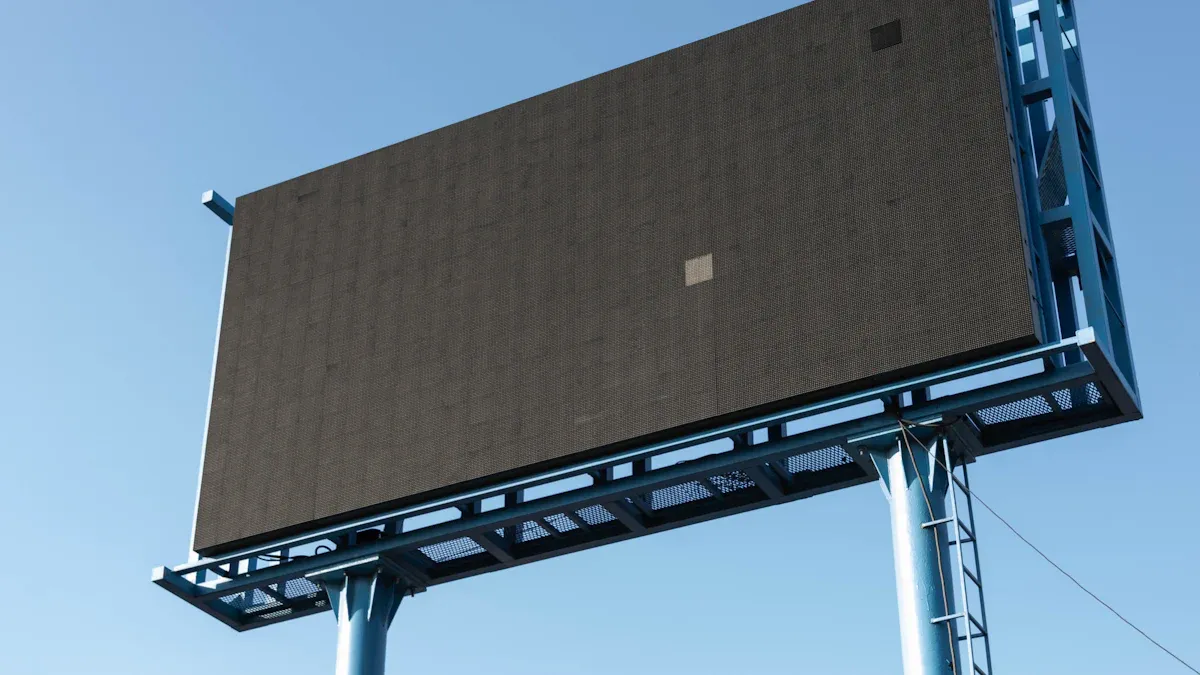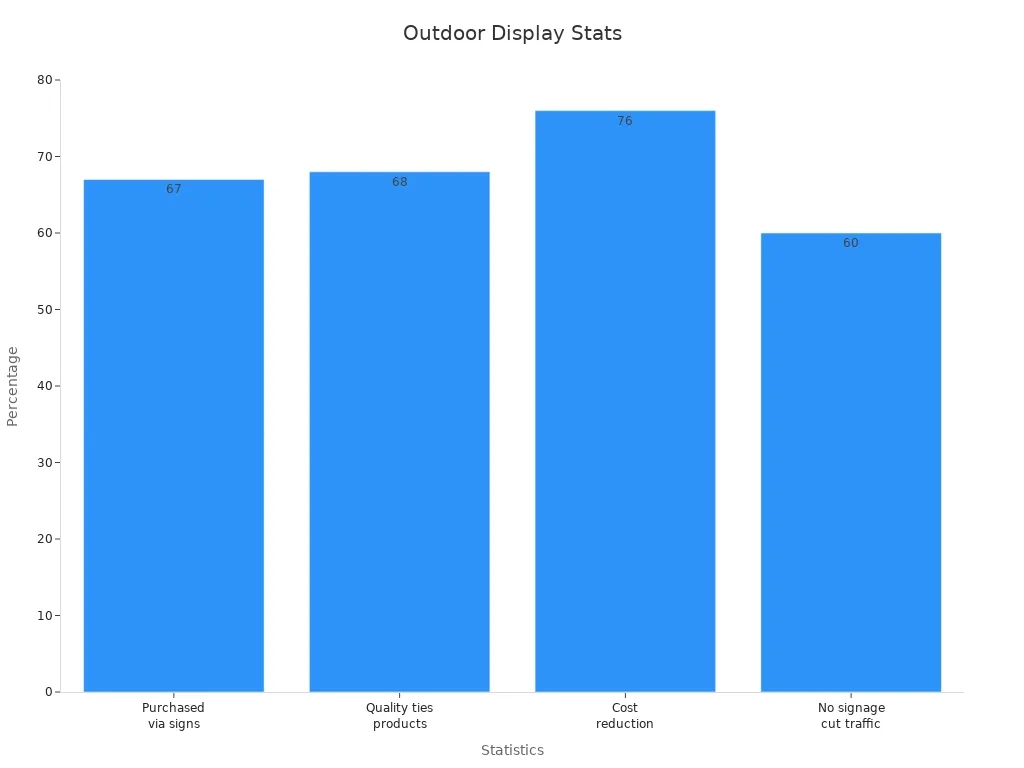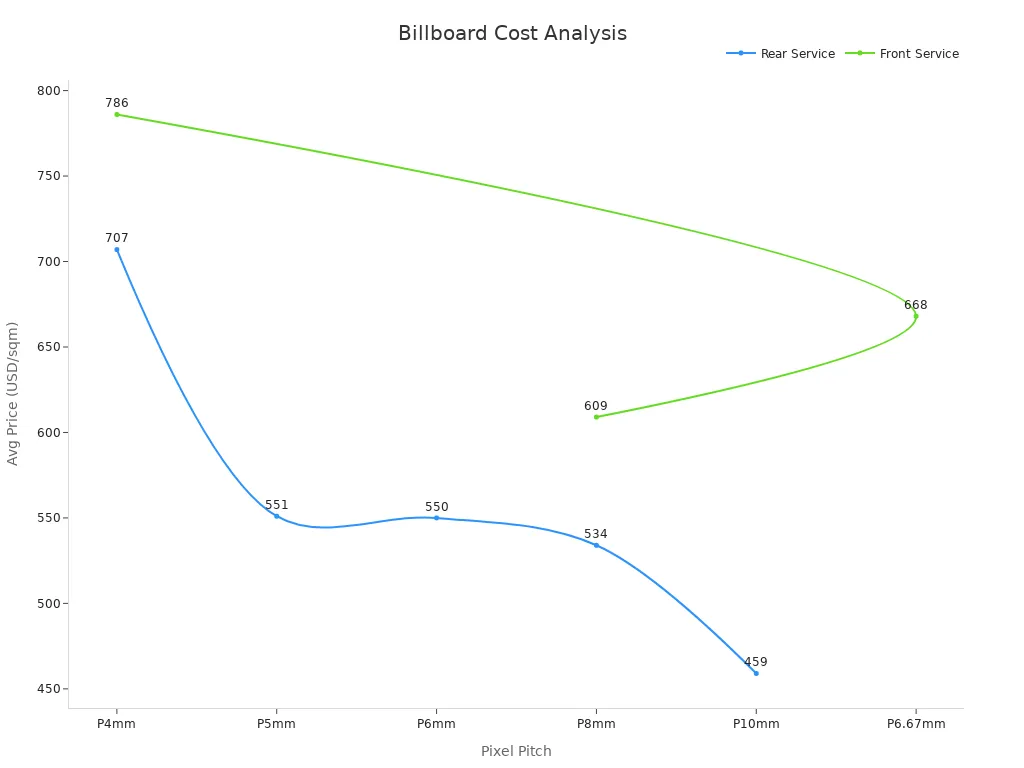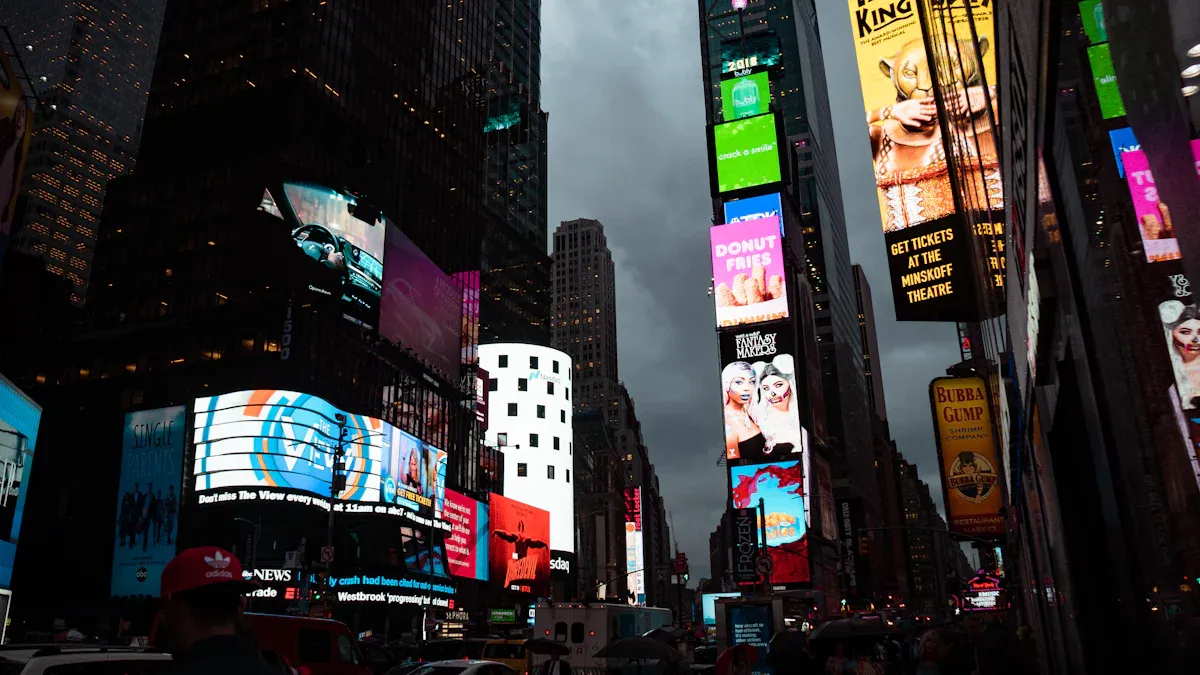Outdoor Display Cabinets: Types, Features, and Installation for Digital Signage

Selecting the right outdoor display cabinets makes a major impact on your outdoor digital signage success. When you use cabinets with strong weatherproof features, your signage stays visible and protected in all conditions. High-quality outdoor digital signage attracts attention and drives engagement. In fact, 67% of consumers have purchased products because of outdoor signs, while 68% link signage quality to product quality. The right features, such as durability and brightness, help your digital displays stand out and last longer. Choosing the best installation approach ensures your signage remains secure and effective.
Statistic Description | Numerical Value | Relevance to Outdoor Display Cabinet Selection |
|---|---|---|
Consumers who purchased products due to outdoor signs | 67% | Indicates effectiveness of outdoor signage in driving sales |
Consumers associating signage quality with product quality | 68% | Highlights importance of high-quality, visible signage enclosures |
Cost reduction in print, paper, and photocopy expenses | 76% | Demonstrates savings from digital signage, supporting investment |
Consumers more likely to walk past store without signage | 60% | Shows necessity of outdoor signage to attract foot traffic |
Engagement metrics (e.g., interaction time, call-to-action) | Quantitative | Measures consumer interaction, guiding cabinet features for interactivity |

Tip: Focus on outdoor display cabinets that combine robust features with easy installation for long-lasting digital signage results.
Key Takeaways
Choose outdoor display cabinets with strong weatherproof ratings like IP65 or higher to protect your signage from rain, dust, and harsh conditions.
Select cabinets with high brightness and anti-glare features to keep your digital displays clear and visible even in direct sunlight.
Pick durable materials such as aluminum or stainless steel to ensure long-lasting protection against rust, impacts, and vandalism.
Plan your installation carefully by assessing the site, using proper mounting tools, and ensuring reliable power and network connections.
Maintain your outdoor displays regularly by cleaning screens, checking seals, and inspecting cables to keep your signage working smoothly and reduce downtime.
Outdoor Display Cabinets Overview
Definition
Outdoor display cabinets protect digital displays in challenging environments. You use these cabinets to keep your signage safe from rain, dust, and physical damage. Industry standards define outdoor display cabinets by their technical features. These include weatherproofing with high IP ratings, such as IP56 or higher, to block water and dust. Cabinets often have IK10 ratings for impact resistance, which helps prevent vandalism. You also find brightness levels above 2,500 nits, which ensures visibility even in direct sunlight. Many cabinets include temperature controls, so your digital signage works from -22°F to 122°F. Manufacturers use strong materials like metal enclosures and tempered glass to keep your digital displays secure. Locking mechanisms and anti-glare coatings add extra protection and improve visibility.
Note: Outdoor display cabinets must meet strict criteria for weather resistance, security, and visibility. These features set them apart from indoor or semi-outdoor units.
Role in Outdoor Digital Signage
You rely on outdoor display cabinets to make your outdoor digital signage effective and long-lasting. These cabinets keep your digital displays running in all weather. They help you reach your audience with clear, bright messages, day or night. The global market for outdoor displays is growing fast. In 2022, the outdoor LED display market reached $7.24 billion and is expected to grow to $23.38 billion by 2030. This growth comes from rising demand for energy-efficient, eco-friendly signage and smart city projects. You see outdoor digital signage in retail, transportation, stadiums, and corporate settings. Enhanced brightness, dynamic content, and interactive features drive adoption. You can choose from many types of outdoor digital signage, such as front-open, high-resolution, and transparent displays. These options help you match your signage to your business needs. Outdoor display cabinets ensure your digital signage stays visible, secure, and reliable, no matter the conditions.
Types of Outdoor Display Cabinets

Outdoor digital signage comes in many forms, each designed for specific environments and business needs. Understanding the main types of outdoor display cabinets helps you choose the right solution for your signage project. Below, you will find a breakdown of the most common types, their features, and how they differ in protection, visibility, and interactive features.
Semi-Outdoor Cabinets
Semi-outdoor cabinets bridge the gap between indoor and fully outdoor displays. You often see these in covered walkways, shopping malls, or under awnings. They offer moderate weather protection and high brightness, making them suitable for areas exposed to indirect sunlight or occasional rain.
Samsung’s XHB series is a leading example. These cabinets are slim, lightweight, and rated IP66 on both sides, ensuring strong waterproofing and reliability.
The heat-dissipating design prevents overheating, which extends the life of your digital displays.
Real-life tests confirm their durability in harsh sunlight and wet conditions.
Energy efficiency stands out, with power consumption as low as 700W/m².
Multiple pixel pitch options and versatile designs adapt to different installation needs.
The lightweight build allows for fast, easy installation, often by a single person.
Thermal management is critical for semi-outdoor cabinets. Every 10°C increase in temperature can halve the lifetime of electronic equipment. Advanced cooling technologies, such as GORE Direct Air Cooling, use ambient air to cool digital signage while maintaining protection against dust and water. This reduces maintenance costs and improves reliability, especially in challenging climates.
Custom Enclosures
Custom enclosures give you the flexibility to design cabinets that fit unique spaces or branding requirements. You can specify the size, shape, color, and materials to match your environment. These enclosures often use aluminum, magnesium alloy, or die-cast aluminum for lightweight strength and corrosion resistance.
Cabinet Material | Pros | Cons |
|---|---|---|
Iron | High strength, customizable size, cost-effective | Heavy, prone to rust and corrosion, limited precision |
Die-Cast Aluminum | Lightweight, high precision, corrosion resistant | Higher cost, susceptible to dents, may need extra cooling |
Carbon Fiber | Extremely lightweight, high strength-to-weight ratio, customizable | High cost, limited availability |
Magnesium Alloy | Extremely lightweight, high structural integrity, excellent thermal dissipation | Higher price, limited availability, less suitable for extreme rugged conditions |
Custom enclosures allow you to balance protection, visibility, and interactive features based on your specific needs. You can add extra security, advanced cooling, or special finishes for branding.
Stand-Alone Displays
Stand-alone displays are self-contained units that you can place almost anywhere outdoors. These cabinets include the screen, enclosure, power supply, and sometimes even network connectivity. You often see them at entrances, plazas, or parking lots.
Stand-alone displays provide high visibility with bright screens and anti-glare coatings.
They offer strong weatherproofing, usually with IP65 or higher ratings.
You can choose models with touchscreens for interactive features, making them ideal for wayfinding or information points.
These displays are easy to relocate and require minimal installation work. Their robust construction protects digital signage from vandalism and harsh weather.
LED Video Walls
LED video walls create large, seamless outdoor displays by combining multiple LED panels. You find these in stadiums, shopping centers, and city squares. They deliver outstanding brightness, color accuracy, and visibility from long distances.
Wide viewing angles (160°+) ensure consistent brightness and color from many positions.
Anti-glare surfaces reduce reflections, improving readability in bright sunlight.
Modular designs prevent bezel gaps, maintaining uniform brightness and color.
MicroLED technology offers even higher brightness, richer colors, and longer lifespan.
Surface-mounted device (SMD) LEDs provide superior color accuracy and consistency.
High refresh rates (120Hz+) reduce image distortion and ensure smooth motion.
These features make LED video walls perfect for dynamic advertising, live events, and public information. You can easily scale them to any size and add interactive features for audience engagement.
Outdoor LCD Displays
Outdoor LCD displays are designed for high visibility in direct sunlight. Standard indoor LCDs with 300-500 nits brightness cannot compete with outdoor lighting. Outdoor LCDs offer at least 1,500 nits, with 2,500+ nits recommended for peak daylight hours.
Research shows that optimizing brightness for outdoor use can increase viewer attention by up to 60%. Digital outdoor displays also boost brand awareness by 46%. Adaptive brightness and anti-glare features help maintain visibility in all lighting conditions, from bright sun to nighttime.
You often use outdoor LCD displays for menu boards, transit information, or retail promotions. Their slim profile and sharp image quality make them ideal for locations where space is limited but visibility is critical.
Interactive Kiosks
Interactive kiosks combine digital displays with touchscreens and other interactive features. You see these at transportation hubs, shopping malls, and tourist attractions. They allow users to search maps, buy tickets, or access information directly.
Interactive kiosks use rugged enclosures to protect against weather and vandalism.
High-brightness screens and anti-glare coatings ensure visibility in outdoor settings.
Advanced cooling systems keep electronics safe from heat and humidity.
You can add features like NFC, QR code scanners, or cameras for enhanced interactivity.
These kiosks improve customer experience by providing self-service options and real-time information. Their interactive features make them a valuable tool for engaging your audience.
Digital Billboards
Digital billboards are large-format LED displays designed for roadside advertising and public messaging. They offer unmatched visibility, even in direct sunlight, thanks to high brightness and durable materials.
Market analysis shows that outdoor LED digital signage increases display brightness by 45% and improves energy efficiency by 30%. Digital signage can boost brand awareness by up to 47.7% and increase average purchase amounts by 29.5%. The ability to update content in real time and target messages makes digital billboards more effective than static signs.
Pixel Pitch | Installation Type | Approximate Price Range (USD per sqm) |
|---|---|---|
P4mm | Rear Service | $648 - $766 |
P4mm | Front Service | $751 - $820 |
P5mm | Rear Service | $514 - $587 |
P6mm | Rear Service | $480 - $620 |
P6.67mm | Front Service | $641 - $694 |
P8mm | Rear Service | $498 - $570 |
P8mm | Front Service | $589 - $628 |
P10mm | Rear Service | $410 - $507 |

Digital billboards use die-cast aluminum cabinets for better heat dissipation and durability. While initial costs are higher, you save money over time by eliminating printing and installation expenses for static signage.
Bus Stop Displays
Bus stop displays provide real-time transit information, advertising, and public messages at transportation shelters. These outdoor displays must withstand constant exposure to weather, vandalism, and heavy use.
High-brightness screens ensure visibility in all lighting conditions.
Weatherproof enclosures protect digital components from rain, dust, and temperature changes.
Interactive features, such as touchscreens or QR codes, allow users to plan routes or access schedules.
You can use bus stop displays to improve passenger experience and generate advertising revenue. Their rugged design ensures reliable operation in busy urban environments.
Open-Frame Cabinets
Open-frame cabinets offer a flexible solution for integrating digital displays into custom structures or kiosks. These cabinets provide the necessary support and protection for outdoor use while allowing you to design the exterior to match your environment.
Certifications such as EN 50125-3 and IEC 61969-3 prove their resistance to shock, vibration, wind, vandalism, and burglary.
Modular designs and thermal management features, like double-walled construction and air conditioning, maintain operational reliability.
Open-frame cabinets are often used in railway stations, outdoor kiosks, and industrial settings.
nVent SCHROFF’s modular outdoor cabinets are a good example. They undergo rigorous testing and certification to ensure safety and effectiveness in harsh environments.
Tip: When choosing among the types of outdoor digital signage, consider the level of protection, visibility, and interactive features you need for your application. Each type offers unique strengths for different outdoor environments.
Key Features of Outdoor Display Cabinets
Weatherproof and IP Rating
You need weatherproof outdoor display cabinets to protect your signage from rain, snow, dust, and humidity. Weatherproofing prevents moisture from entering the cabinet, which can cause short circuits and equipment failure. The IP (Ingress Protection) rating measures how well your cabinet resists solids and liquids. For outdoor digital signage, you should look for cabinets with an IP65 rating or higher. This rating means your cabinet is dust-tight and can withstand water jets from any direction.
Note: Studies show that 75% of electronic failures happen because of moisture, dust, or extreme temperatures. Proper weatherproofing and high IP ratings help you avoid costly repairs and downtime.
You can also use NEMA ratings to compare protection levels. The table below shows how NEMA and IP ratings match up:
NEMA Rating | Protection Description | Equivalent IP Rating |
|---|---|---|
NEMA 3 | Protection against rain, sleet, wind-blown dust; suitable for outdoor use | IP54 |
NEMA 3R | Protection against rain, sleet, snow, ice; outdoor electrical applications | IP14 |
NEMA 4 | Protection against water ingress (including hose-directed water) and dust; suitable for washdowns | IP66 |
NEMA 4X | Water-tight, dust-tight, corrosion resistant; suitable for harsh environments and washdowns | IP66 |
NEMA 6 | Protection against hose-directed water, ice formation, and temporary submersion | IP67 |
NEMA 6P | Protection against hose-directed water, ice, and prolonged submersion | IP68 |

When you choose cabinets with IP65 or higher, you ensure your outdoor displays stay reliable in harsh weather. Certified IP65 signage passes strict tests for dust and water resistance, so you can trust your investment to last.
Brightness and Anti-Glare
Visibility is critical for outdoor digital signage. You want your content to stand out, even in direct sunlight. Outdoor displays need high brightness levels, usually above 2,500 nits, to remain readable during the day. Anti-glare coatings help reduce reflections, so your audience can see your message clearly from any angle.
Tip: Enhanced visibility in direct sunlight increases engagement and makes your signage more effective.
Adaptive brightness features adjust the screen automatically based on ambient light. This saves energy and extends the life of your display. You get consistent visibility and lower operating costs.
Material and Durability
The materials you choose for your outdoor display cabinets affect their durability and lifespan. Steel and aluminum are the most common choices. Steel offers high tensile strength and resists heavy loads, wind, and temperature changes. It keeps its shape over time and stands up to harsh outdoor conditions. Aluminum is lightweight and resists corrosion, making it ideal for moist or coastal environments. Stainless steel provides extra protection against rust and pollution.
Steel frames resist warping and UV damage.
Aluminum is easy to machine and install but may flex under pressure.
UV-resistant finishes protect against color fading and sun damage.
You should select materials based on your location and the level of weather resistance you need. Durable materials help your signage last longer and reduce maintenance costs.
Security
Security features protect your outdoor digital signage from vandalism and theft. You need cabinets with shatterproof glass, tamper-proof enclosures, and strong locking mechanisms. Stainless steel or reinforced aluminum enclosures keep your internal hardware safe. Some cabinets include smart security features like alarms or remote monitoring. These features help you detect and prevent tampering in real time.
Note: Vandal-proof designs are essential in high-traffic areas. They reduce downtime and protect your investment.
Security cameras and dome housings can also deter vandalism. Mounting your signage high above the ground makes it harder to reach and damage.
Temperature Control
Outdoor environments can get very hot or cold. You need temperature control features to keep your signage working in all seasons. Built-in cooling fans, heaters, and ventilation systems maintain a safe temperature inside the cabinet. This prevents overheating in summer and freezing in winter.
Temperature resistance features allow your outdoor displays to operate from -30°F to 120°F. Consistent temperature control protects your digital components and ensures real-time content management without interruptions.
Accessibility and Maintenance
Easy access for maintenance is important for managing your outdoor digital signage. Cabinets with front or rear access panels let you reach internal components quickly. Tool-less entry systems save time and reduce the risk of damage during repairs.
Tip: Choose cabinets with modular designs. You can replace parts easily and keep your signage running with minimal downtime.
Regular maintenance keeps your displays clean and functional. Good accessibility features support real-time updates and efficient content management.
Lightning Protection
Lightning strikes and power surges can damage your outdoor displays. You need lightning protection features such as surge protectors and grounding systems. These features shield your signage from electrical spikes and keep your content management systems safe.
Proper lightning protection reduces the risk of costly repairs and data loss. It also ensures your signage continues to deliver real-time updates and interactive features, even during storms.
Remember: Investing in the right features for your outdoor display cabinets helps you achieve reliable performance, enhanced visibility, and long-term savings. You protect your digital signage, improve content management, and deliver real-time information to your audience.
Installation of Outdoor Display Cabinets

A successful installation of outdoor display cabinets requires careful planning and attention to detail. You can follow these steps to ensure your digital signage performs reliably and safely in any environment.
Site Assessment
Start your installation with a thorough site assessment. You need to evaluate the location for visibility, sunlight exposure, and weather conditions. At EZ Go Stores in Lawton, OK, a detailed site assessment helped the team select the right technology and address factors like brightness, weather protection, power, and legal restrictions. This approach ensures your installation services meet customer needs and comply with local codes. Always check for obstacles, access to power, and safe mounting surfaces before you install outdoor digital signage.
Assess sunlight direction and brightness levels.
Check for wind exposure and potential flooding.
Confirm access to power and network connections.
Review local regulations for signage placement.
Mounting and Alignment
Proper mounting and alignment keep your display secure and visible. Use self-leveling tools to ensure the cabinet sits straight and stable. Choose mounting brackets rated for outdoor use and the weight of your cabinet. Installation services should always double-check alignment for the best viewing angle and safety.
Power and Connectivity
Reliable power and network connections are essential for outdoor digital signage. Use shielded cables to protect against moisture and electrical interference. The table below summarizes best practices for power and connectivity during installation:
Aspect | Recommendation |
|---|---|
Cable Type | Use shielded cables for outdoor environments |
PoE Injectors | Select outdoor-rated injectors with weatherproofing |
PoE Extenders | Extend cable runs beyond 100m as needed |
Switch Type | Use managed switches for advanced control |
Equipment Ratings | Ensure all equipment meets IP, UL, and NEMA standards |
Network Cable Categories | Use Cat6 or higher for better shielding and speed |
Installation services should match equipment to your data and power needs for consistent performance.
Weatherproof Sealing
Weatherproof sealing protects your investment from rain, dust, and extreme temperatures. Industry testing confirms that advanced gasket seals, hydrophobic coatings, and marine-grade materials keep cabinets safe for 5–7 years or more. Installation services should use UV-resistant panels and anti-condensation features to prevent moisture buildup. Always check that all seals and drains work properly before completing the installation.
Use powder-coated steel or stainless steel for corrosion resistance.
Install temperature control systems for stable operation.
Ensure all gaskets and seals are intact and properly fitted.
Testing and Maintenance
After installation, test your display for power, connectivity, and weatherproofing. Regular maintenance keeps your signage running smoothly. Follow a structured routine:
Clean screens with soft cloths.
Inspect cables and connections monthly.
Check ventilation and cooling systems.
Schedule quarterly hardware evaluations.
Installation services should provide a maintenance plan to extend the life of your outdoor display cabinets and reduce downtime.
Tip: A well-planned installation and regular maintenance ensure the ease of installation and long-term performance of your digital signage.
You set your signage up for long-term success when you choose the right outdoor digital display cabinet. High-quality outdoor displays with weatherproof features, strong visibility, and robust content management systems reduce maintenance and maximize uptime. Modular construction and remote content management make real-time updates easy, while energy-efficient LED technology lowers costs. For successful outdoor digital signage, assess your needs, consult with experts, and prioritize durability and weather resistance.
Contact trusted suppliers for product recommendations
Schedule a site assessment before installation
Review your content management and real-time update needs
Plan for ongoing management and maintenance to boost customer engagement
FAQ
What IP rating should you choose for outdoor display cabinets?
You should select cabinets with at least an IP65 rating. This rating keeps your digital signage safe from dust and water. Higher ratings offer even more protection in harsh environments.
How do you maintain outdoor digital signage cabinets?
You should clean the screens regularly, check seals for leaks, and inspect cables for damage. Schedule quarterly hardware checks. Quick maintenance helps your signage last longer and work better.
Can you install outdoor display cabinets yourself?
You can install some cabinets if you have basic tools and follow safety guidelines. For large or complex displays, you should hire professionals. They ensure proper mounting, wiring, and weatherproofing.
What materials work best for outdoor display cabinets?
Aluminum and stainless steel work best. These materials resist rust and damage from weather. They also provide strong protection against impacts and vandalism.
How do you keep outdoor displays visible in sunlight?
You should use cabinets with high-brightness screens and anti-glare coatings. These features help your content stay clear and readable, even in direct sunlight.
See Also
Indoor And Outdoor Digital LED Signage Display Comparison
Exploring Technology Benefits And Strategies For Digital Signage
Key Technical Specs And Criteria For Choosing Signage Screens
Customized Digital Signage Solutions For Retail Healthcare Corporate

